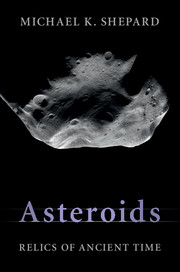Book contents
- Frontmatter
- Dedication
- Contents
- Preface
- Acknowledgements
- Brief list of asteroid and meteorite terms
- 1 It's a small world
- 2 A night at the zoo
- 3 It came from outer space
- 4 A day at the museum
- 5 The gambler's fallacy
- 6 Remembrance of things past
- 7 The ties that bind
- 8 Terra incognita
- 9 To your scattered bodies go
- 10 Scouts, sappers, and miners
- Glossary
- Bibliography
- Index
- References
6 - Remembrance of things past
Published online by Cambridge University Press: 05 May 2015
- Frontmatter
- Dedication
- Contents
- Preface
- Acknowledgements
- Brief list of asteroid and meteorite terms
- 1 It's a small world
- 2 A night at the zoo
- 3 It came from outer space
- 4 A day at the museum
- 5 The gambler's fallacy
- 6 Remembrance of things past
- 7 The ties that bind
- 8 Terra incognita
- 9 To your scattered bodies go
- 10 Scouts, sappers, and miners
- Glossary
- Bibliography
- Index
- References
Summary
Study the past, if you would divine the future.
Confucius
IN THE HOOD
The instructions were clear and sobering. If I got any HF on me, short for hydrofluoric acid, I was to call for help. I would be led down the hall to the lounge where, from the refrigerator that stored our lunches, one of my colleagues would remove the calcium gluconate gel and apply it to the burn. Injectable calcium gluconate was also available and might be administered as well. Then I would be taken to the nearest hospital for further observation and IV administration of more calcium gluconate. Without these treatments, the acid burn could be fatal.
Hydrofluoric acid is one of the most potent acids available to chemists. Of all the acids, it comes closest to the alchemists' dream of a “universal solvent.” Given time, it dissolves almost everything, including glass, so it has to be kept and mixed in special Teflon containers. If it gets on skin, it will penetrate more deeply than other acids and cause extensive tissue damage and terrible pain. After dissociating in the tissue, fluorine, the most reactive element in the entire periodic table, will rapidly bind with calcium and magnesium electrolytes in the blood and cells, wreaking havoc on electrolyte levels. Depending on the dose, this could lead to spasms, seizures, organ failure, and even cardiac arrest. They had my attention.
I was garbed in full battle regalia. I had two aprons, the inner one a standard lab apron, and the outer one made of a special rubber. Likewise, I wore two layers of gloves. The outer gloves, also a thick rubber, came well up my forearms. Finally, I wore a full face shield that, while clear, covered the front of my face from the top of my head to well below my chin.
I worked at a special chemical workstation called a fume hood. These are laboratory benches that are fully enclosed with a windowlike opening on the side facing the chemist.
- Type
- Chapter
- Information
- AsteroidsRelics of Ancient Time, pp. 159 - 190Publisher: Cambridge University PressPrint publication year: 2015



